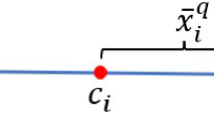Abstract
This study proposes an efficient wall-following and navigation control model that includes three control modes, namely w all-f ollowing (WF), t oward-g oal (TG), and b ehavior m anager (BM). To achieve an adaptive controller for WF mode, an efficientr ecurrent f uzzy c erebellar m odel a rticulation c ontroller (RFCMAC) based on d ynamic g roup a rtificial b ee c olony (DGABC) is proposed for implementing reinforcement learning process. The fitness function includes four assessment factors which are defined as follows: (1) maintaining safe distance between the mobile robot and the wall; (2) ensuring successfully running a cycle; (3) avoiding mobile robot collisions; (4) mobile robot running at a maximum speed. Moreover, the BM is used to switch WF mode and TG mode, and is employed as an escape mechanism based on the relationship between the robot and the environment. The experimental results show that the proposed DGABC is more effective than the traditional ABC in WF mode. The proposed control method also obtains a better navigation control than other methods in unknown environments.
Similar content being viewed by others
References
van Turennout, P., Honderd, G., van Schelven, L. J.: Wall-following control of a mobile robot. IEEE Int. Conf. Robot. Autom. 1, 280–285 (1992)
Kwolek, B.: The usage of hidden markov models in a vision system of a mobile robot, Second Workshop on Robot Motion and Control, pp. 257-262, 18–20 (2001)
Chi, C. T., Wang, Y. T., Cheng, S. T., Shen, C. A.: Robot simultaneous localization and mapping using a calibrated kinect sensor. Sens. Mater. 26(5), 353–364 (2014)
Lefèvre, S., Fluck, C., Maillard, B., Vincent, N.: A fast snake-based method to track football players. In: IAPR International Workshop on Machine Vision Applications, Tokyo (Japan), pp. 501–504 (2000)
Gavrilut, I., Tiponut, V.: Wall-following method for an autonomous mobile robot using two ir sensors. Inter. Conf. Syst. 1, 205–209 (2008)
Thongchai, S., Suksakulchai, S., Wilkes, D.M., Sarkar, N.: Sonar behavior-based fuzzy control for a mobile robot. IEEE Int. Conf. Syst. Man Cybern. 5, 3532–3537 (2000)
Al-Sahib, N. K. A., Ahmed, R. J.: Guiding mobile robot by applying fuzzy approach on sonar sensors. AI-Khwarizmi Eng. J. 6(3), 36–44 (2010)
Lin, C. T., George Lee, C. S.: Neural Fuzzy Systems: A Neuro-Fuzzy Synergism to Intelligent Systems. Prentice-Hall, New Jersey (1996)
Albus, J. S.: A new approach to manipulator control: the cerebellar model articulation controller (CMAC). J. Dyn. Syst. Meas. Control, Trans. ASME 97, 220–227 (1975)
Lee, C. Y., Lin, C. J., Chen, H. J.: A self-constructing fuzzy CMAC model and its applications. Inf. Sci. 177(1), 264–280 (2007)
Shieh, H. L., Bao, C. Y.: A robust fuzzy cmac for function approximation. Int. Conf. Mach. Learn. Cyber. 6, 2962–2966 (2010)
Lane, S. H., Militzer, J.: A comparison of five algorithm for the training of CMAC memories for learning control systems. Int. Fed. Automat. Contr. 28(5), 1027–1035 (1992)
Lin, C. S., Li, C. K.: A new neural network structure composed of small CMACs. In: Proceedings of IEEE Conference on Neural Systems, pp 1777–1783 (1996)
Bezdek, J.C., Ehrlich, R.: FCM: The Fuzzy c-means Clustering algorithm. Comput. Geosci. 10, 191–203 (1984)
Hsu, C. H., Juang, C. F.: Evolutionary robot wall-following control using type-2 fuzzy controller with species-de-activated continuous ACO. IEEE Trans. Fuzzy Syst. 21(1), 100–112 (2013)
Hsu, C. H., Juang, C. F.: Multi-objective continuous-ant-colony-optimized fc for robot wall-following control. IEEE Comput. Intell. Mag. 8(3), 28–40 (2013)
Kennedy, J., Eberhart, R.: Particle swarm optimization. IEEE Int. Conf. Neural Netw. 4, 1942–1948 (1995)
Dorigo, M., Caro, G. D.: Ant colony optimization: a new meta-heuristic. In: Proceedings of the 1999 Congress on Evolutionary Computation, vol. 2, pp 1470–1477 (1999)
Storn, R., Price, K.: Differential evolution – a simple and efficient heuristic for global optimization over continuous spaces. J. Glob. Optim. 11(4), 341–359 (1997)
Karaboga, D., Basturk, B.: A powerful and efficient algorithm for numerical function optimization: artificial bee colony (ABC) algorithm. J. Glob. Optim. 39(3), 459–471 (2007)
Wang, J. G., Tai, S. C., Lin, C. J.: Medical diagnosis applications using a novel interactively recurrent self-evolving fuzzy CMAC model. In: 2014 International Joint Conference on Neural Networks (IJCNN), pp. 4092–4098 (2014)
Chen, H., Cui, D. W., Li, X., Wang, Z. M.: Adaptation ethnic group evolution algorithm. In: IEEE Conference on Cybernetics and Intelligent Systems, pp 1181–1186 (2008)
Li, L., Lin, C.J., Huang, M.L., Kuo, S.C., Chen, Y.R.: Mobile robot navigation control using recurrent fuzzy cmac based on improved dynamic artificial bee colony. Adv. Mech. Eng. 8(11). https://doi.org/10.1177/1687814016681234 (2016)
Jun, S., Xu, W., Feng, B.: A global search strategy of quantum-behaved particle swarm optimization. In: Cybernetics and Intelligent Systems IEEE Conference, vol. 1, pp 111–116 (2004)
Gong, W., Cai, Z.: Differential evolution with ranking- based mutation operators. IEEE Trans. Cybern. 43(6), 2066–2081 (2013)
Zhang, J., Arthur, C.: JADE: adaptive differential evolution with optional external archive. IEEE Trans. Evol. Comput. 13(5), 945–958
Author information
Authors and Affiliations
Corresponding author
Rights and permissions
About this article
Cite this article
Lin, TC., Chen, CC. & Lin, CJ. Wall-following and Navigation Control of Mobile Robot Using Reinforcement Learning Based on Dynamic Group Artificial Bee Colony. J Intell Robot Syst 92, 343–357 (2018). https://doi.org/10.1007/s10846-017-0743-y
Received:
Accepted:
Published:
Issue Date:
DOI: https://doi.org/10.1007/s10846-017-0743-y




